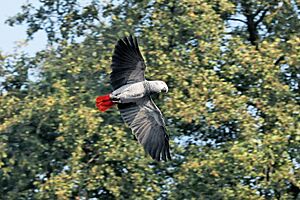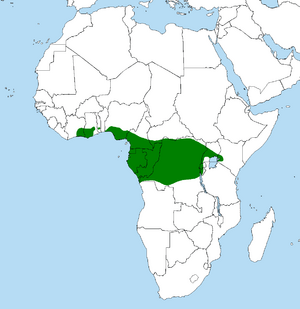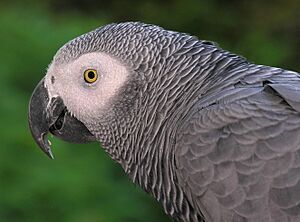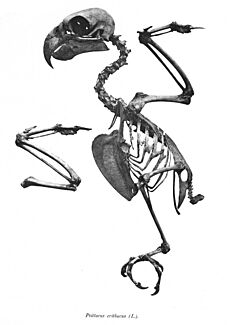Grey parrot facts for kids
Quick facts for kids Grey parrot |
|
|---|---|
 |
|
 |
|
| Conservation status | |
| Scientific classification | |
| Genus: |
Psittacus
|
| Species: |
erithacus
|
 |
|
| Range | |
| Synonyms | |
|
Psittacus cinereus Gmelin, 1788 |
|
The grey parrot (Psittacus erithacus), also known as the Congo grey parrot or African grey parrot, is a type of parrot found in Africa. These amazing birds are known for their intelligence and ability to copy human speech. Another parrot, the Timneh parrot, used to be thought of as a type of grey parrot, but scientists now know it's a separate species.
Contents
About the Grey Parrot
Grey parrots are medium-sized birds. They are mostly grey with a black beak. An adult grey parrot usually weighs about 400 grams (14 ounces). They are about 33 centimeters (13 inches) long, and their wings can spread out to 46–52 centimeters (18–20.5 inches). Their heads and wings are a bit darker than their bodies. The feathers on their heads and bodies have small white edges, and their tail feathers are bright red.
Sometimes, due to special breeding, some grey parrots can be partly or completely red. Both male and female grey parrots look very similar. Young grey parrots look like adults, but their eyes are dark grey or black. Adult grey parrots have yellow eyes with dark pupils.
Grey parrots can live a long time! In people's homes, they can live for 40 to 60 years. In the wild, they usually live for about 23 years. They start having babies when they are 3 to 5 years old.
Where Grey Parrots Live
Grey parrots live in the middle part of Africa. You can find them in countries like Angola, Cameroon, Congo, Gabon, Ghana, Kenya, and Uganda. They prefer to live in thick forests, but you can also find them at the edges of forests or in more open areas with trees.
Scientists aren't sure exactly how many grey parrots there are in the world. Estimates range from 630,000 to 13 million birds. Sadly, their numbers are going down almost everywhere. For example, a study in 2015 found that most grey parrots had disappeared from Ghana. Their numbers dropped by 90% to 99% since 1992! People there mostly blame the pet trade and cutting down trees for this big decline.
In the Congo, about 15,000 grey parrots are taken from the wild each year to be sold as pets. This is much more than the allowed limit of 5,000 birds per year.
Behaviour and Life in the Wild
We don't know a lot about how grey parrots behave in the wild. It's hard to study them because they are prey animals, meaning other animals hunt them. This makes them very secretive.
Wild grey parrots can also copy many sounds they hear, just like pet parrots. In the Congo, two wild grey parrots were recorded making over 200 different sounds! This included nine sounds of other wild birds and even one sound of a bat.
What Grey Parrots Eat
Grey parrots mainly eat fruit, nuts, and seeds. They especially like oil palm fruit. Sometimes, they also eat flowers, tree bark, insects, and snails. In the wild, they sometimes look for food on the ground.
Reproduction and Life Cycle
Grey parrots find one partner and stay with them. They build their nests in holes inside trees. Each pair of parrots needs its own tree for their nest. The female parrot lays three to five eggs. She sits on the eggs for 30 days to keep them warm, and her mate brings her food. The parents protect their nesting spots.
Baby grey parrots need a lot of feeding and care from their parents in the nest. The parents look after them until about 4 to 5 weeks after they learn to fly. Young parrots leave the nest when they are about 12 weeks old. When they hatch, they weigh about 12–14 grams (0.4–0.5 ounces). When they leave their parents, they weigh about 372–526 grams (13–18.5 ounces).
Conservation of Grey Parrots
In the wild, grey parrots are hunted by animals like palm-nut vultures and other birds of prey. Monkeys sometimes eat their eggs and young.
But humans are the biggest threat to grey parrots. Between 1994 and 2003, over 359,000 grey parrots were sold around the world. About 21% of the wild population was being taken each year. Many birds die between the time they are caught and when they reach the market, with 60% to 66% not surviving. Grey parrots are also hunted for their meat and for parts of their bodies used in traditional medicines.
Because so many wild birds are taken, and because their homes are being destroyed, the number of grey parrots in the wild is quickly going down. This is why they are now listed as an endangered species by the International Union for Conservation of Nature.
In 2016, an important group called CITES (Convention on the International Trade of Endangered Fauna and Flora) gave grey parrots the highest level of protection. This means that international trade of these birds is now very strictly controlled. In Kenya, in 2021, people who owned grey parrots could pay a fee to get a permit. Now, it is against the law to own a grey parrot without this permit.
Grey Parrots as Pets
Grey parrots are very common pets. People love them because they can copy human speech, which makes them one of the most popular pet birds. One pet parrot in Japan even flew away but was returned to its owner after it kept repeating the owner's name and address!
Grey parrots are famous for copying noises they hear around them and using them all the time. They are very smart birds. Because they are so intelligent, they need a lot of things to keep them busy and happy when they are pets. They also need a lot of attention. If they don't get enough, they can become stressed. A common sign of stress in pet grey parrots is pulling out their own feathers. They can also have other behavior problems because they are very sensitive birds. Being alone can make them stressed and age faster.
Grey parrots are very social animals. In the wild, they live in flocks. Even when they are pets, they still need to feel like they are part of a "flock," which is usually their human family. They learn to "talk" by interacting with the humans they live with. Both wild and pet parrots use special "contact calls." These calls help them talk to their flock mates (or human family) about where they are, if there's danger, if there's food, and if they are safe. These calls also help them form strong bonds. Pet grey parrots have even shown that they can use human language correctly and in a way that fits the social situation.
What Pet Grey Parrots Eat
Pet grey parrots can eat special bird pellets. They also enjoy many fruits like pear, orange, pomegranate, apple, and banana. For vegetables, they can eat carrot, cooked sweet potato, celery, fresh kale, green beans, and peas. It's also important for them to get enough calcium.
Health Issues
Pet grey parrots can sometimes get fungal or bacterial infections. They might also not get enough nutrients, or they can get tumors. They can also get a disease called psittacine beak and feather disease, which is more common in young parrots. Birds with this disease might lose their appetite, have fluffy feathers, be slow, and have weak bones.
Grey parrots are also more likely to get rhinitis, which is when their nasal passages get inflamed and infected. Signs of this can include wheezing, sneezing, sniffling, or swelling around their nostrils.
Intelligence and Learning
Grey parrots are incredibly smart! They are considered one of the most intelligent types of parrots. Many grey parrots can do tasks that are similar to what a four- to six-year-old human child can do. Scientists have done many studies that show their high-level thinking abilities.
Experiments have shown that grey parrots can learn number sequences. They can also learn to connect human voices with the faces of the people who make those voices. It's even been reported that grey parrots can use words they already know to make up new names for objects they don't know. For example, one parrot called an apple "banerry" (banana + cherry) or dried banana chips "banana crackers."
A famous grey parrot named Alex worked with an American scientist named Irene Pepperberg. Alex learned over 100 words and could tell the difference between objects, colors, materials, and shapes. Dr. Pepperberg spent many years working with Alex and wrote many scientific papers about his amazing abilities. One study found that Alex could even add numbers and understood the idea of "zero," just like young children and apes.
Besides being smart, grey parrots have also shown that they can be kind and caring towards others. Researchers found that grey parrots would share a nut with another parrot, even if it meant they wouldn't get one themselves. When the other parrot had a chance, they would usually return the favor! This shows they can be selfless and also understand the idea of "you scratch my back, I'll scratch yours."
A study in 2012 showed that pet grey parrots have their own favorite types of music. When given a choice between two songs on a touchscreen, the parrots consistently chose different songs. Then, they would dance and sing along! Some pet grey parrots have even been seen using smart speakers (like Google Nest) to ask for their favorite songs to be played.
Some research suggests that which foot a parrot prefers to use might be linked to how many words it knows. Grey parrots who prefer to use their right foot often know more words than those who prefer their left foot. Scientists think that parrots might use different sides of their brain for different tasks, just like humans do.
Color Changes
Grey parrots can have natural color changes, also called mutations. These include the Blue Ino (which is all white), the Incomplete Ino (which has light color), and the Blue varieties (which have a white tail).
Breeders in different countries have been breeding grey parrots since the 1800s to create new color variations. These include the Red Pied, F2 Pied, Grizzles, Ino, Incomplete, Parino, Lutino, Cinnamon, and Red Factor. Some breeders even created the first Red Factor Greys, which are mostly red. These are rare and can be quite expensive!
History of Grey Parrots and Humans
People have kept grey parrots as pets for a very long time, going back to 2000 B.C. Ancient Egyptian pictures show these birds as pets. The ancient Greeks and Romans also thought they were valuable and kept them in cages.
Because of illegal trading in recent years, grey parrots were listed as Endangered in 2016 on the IUCN Red List.
Images for kids









